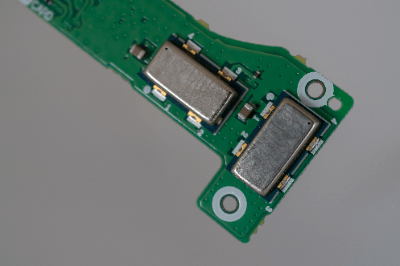What Is an Acceleration Sensor?

An acceleration sensor is a sensor that measures acceleration.
Acceleration is the increase in velocity per unit of time. In physics, acceleration is an important parameter that can exert a force on an object.
An acceleration sensor can be broadly classified into capacitive, piezoelectric (piezoresistive), and thermal sensing methods. There are differences in the acceleration that can be detected by the sensors of each method. The capacitive method can detect gravitational acceleration, while the piezoelectric (piezoresistive) method cannot.
Uses of Acceleration Sensors
Acceleration sensors are used to measure acceleration simply as well as to measure other parameters via acceleration. Uses for the former include sensors built into smartphones and portable game consoles, sensors for shock detection to activate car airbags, and other sensors such as seismometers. The latter include inclinometers and pedometers that use capacitance method acceleration sensors capable of detecting gravitational acceleration.
Principle of Acceleration Sensors
Acceleration sensors are broadly classified into capacitance method, piezoelectric (piezoresistive) method, and thermal sensing method. The basic principle of each method is the same: the sensor is divided into a fixed part and a flexible part. When acceleration is applied to the accelerometer, the flexible part deforms.
The difference between the fixed part and the deformed flexible part is detected by the element, and the acceleration is measured. In the capacitance method, each of the fixed and flexible parts has an electrode. The configuration of the sensor is a comb-like array of alternating fixed and flexible parts with electrodes.
Since the capacitance between the electrodes of the fixed part and the flexible part changes when acceleration is applied, the acceleration can be determined from the amount of change. Figure 1 shows an example of a pedometer that detects gravitational acceleration using a 3-axis acceleration sensors.
(a) is the data directly measured by the sensor and represents the time series data of the acceleration of the body’s center of gravity when the pedometer is attached to the proper position of the pedestrian. This data contains gravity acceleration as a low frequency (DC) component, and by applying a low-pass filter, only the gravity acceleration is extracted, as in data (b).
At the same time, by applying a bandpass filter to data (a), data (c) is obtained by removing the low-frequency gravity acceleration component and the high-frequency noise component. Data (b) and (c) are time-series data in the three axes (x, y, z), respectively, and if the orientation of the sensor changes during walking (measurement), the values detected in each axis will also change.
Here, by taking the inner product of the data (b) and (c) (i.e., the inner product of 3D vectors) at each time, it is possible to obtain time series data of the gravity direction component (one axis) of the body center of gravity acceleration, as shown in data (d).
In this way, the gravity direction component of the pedestrian’s acceleration can be obtained, regardless of the orientation of the sensor, in positive projection to the gravity acceleration, i.e., the vector quantity is converted to a scalar quantity, and based on this data (d), the walking pitch and number of steps can be calculated.
The piezoelectric (piezoresistive) method uses a piezoelectric element to measure acceleration. The piezoelectric element generates an electric current when it is deformed by acceleration. The generated current is measured as acceleration.
Other Information on Acceleration Sensors
1. Difference between Acceleration Sensors and Gyroscopes
One sensor that has a similar performance to acceleration sensors are gyro sensor. Here, we will explain the difference between accelerometers and gyro sensors.
As the name suggests, acceleration sensors are used to measure acceleration. Gyro-sensors, on the other hand, are designed to measure angular velocity. Which means that the physical quantities they detect are different.
Gyro-sensors use the Coriolis force to detect the orientation and posture of an object, which is then output as an electrical signal. They are used when measuring the tilt of an object and are installed in a wide variety of electronic devices such as car navigation systems, digital cameras with image stabilization, smartphones, and game consoles.
Combining acceleration sensors with a gyro sensor can also be used to measure the motion of an object in more detail. For example, a car navigation system, one of the most popular in-vehicle products, uses a combined sensor technology.
The gyro sensor can determine the direction of the car, and the acceleration sensors can determine the distance traveled, making it possible to accurately display the current location even in places where radio waves are difficult to reach, such as in tunnels.
2. How to use Acceleration Sensors
To use acceleration sensors to realize the desired application, the required measurement range or frequency bandwidth must be confirmed in advance. For example, if acceleration sensors are to be mounted on a game console controller, it must have a measurement range that exceeds the required range, assuming that the user will be shaking the controller to operate it.
Once the appropriate acceleration sensors for the measurement target are determined, the sensor is wired, and the measurement program is created. At this point, the “parameter setting” is important. In the parameter settings, you can change the sensitivity of the sensor, the 0g (zero gravity acceleration) output level, and so on. If these are not set appropriately, it will be difficult to realize the desired application.